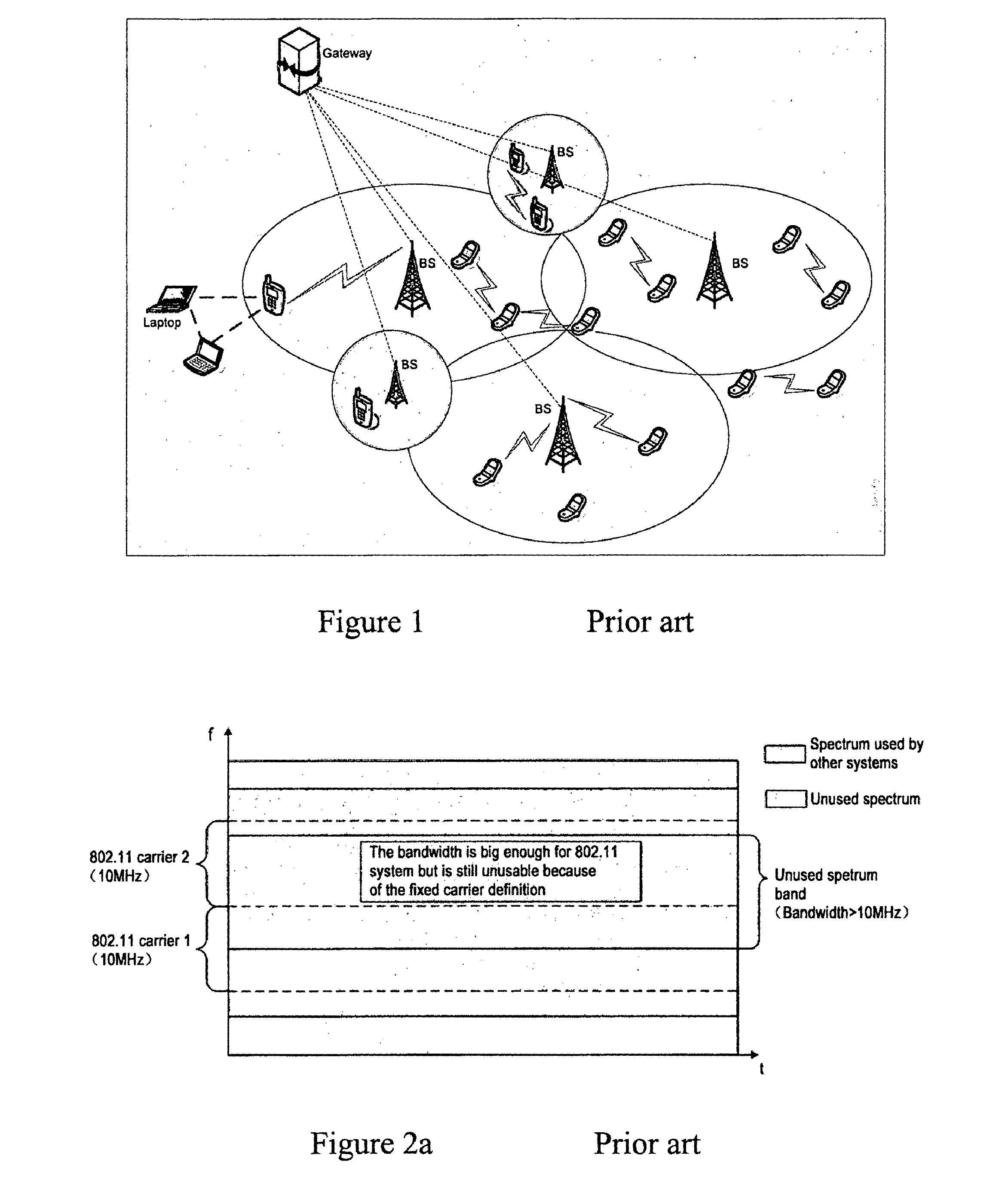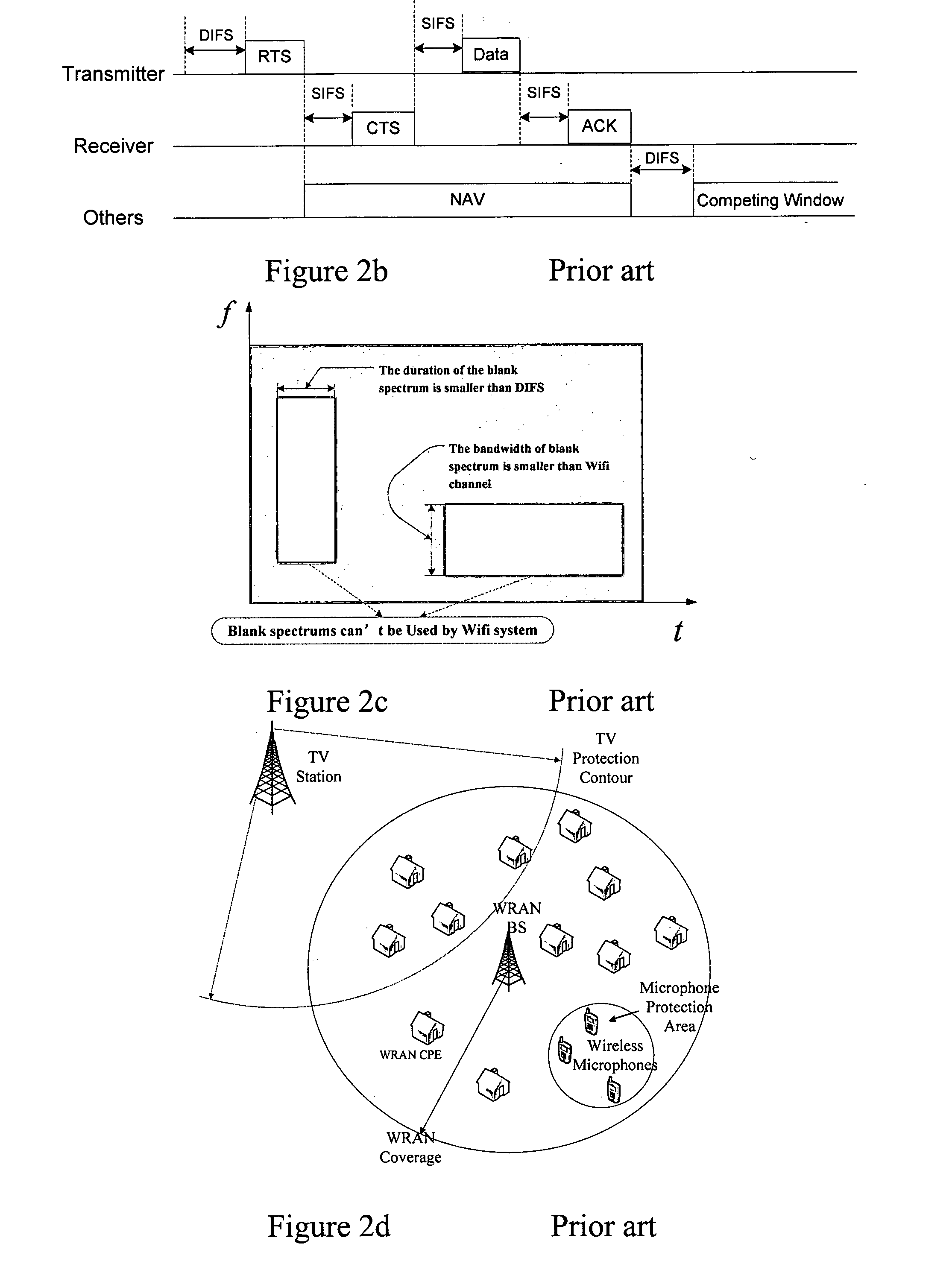The main benefit of such an operation is an easy resource and interference control, but an obvious drawback is inefficient
resource utilization.
Basically, in such a
hybrid network, critical problems mainly occur from resource sharing and interferences present in the
system.
But the position and bandwidth of the
usable spectrum in TVWS is probably unstable, and sometimes the available spectrum is fragmentary.
The fixed predefined
system carrier and bandwidth is not suitable for the D2D communication on TVWS bands.
As shown in FIG. 2, there are enough spectrum resources for the 802.11 systems, but they cannot be used by the 802.11 systems because of the problem caused by the fixed carrier definition.
But the sensing-report-decision mechanism can only work in a slowly varying environment rather than a highly dynamic one, which is probably the case of open White Spaces spectra.
On the other hand, terminals may sense different available spectrum gaps under severe competition situation.
The
base station just defines the common spectrum as the
system's frequency based on the sensing results of different terminals, which will decrease the efficiency of the
resource utilization.
Thus, it is clear that the channel defining method of the 802.22 system is not good enough for the D2D communication on the TVWS band either.
The resource partition mechanisms of IEEE 802.11 and 802.22 systems are both unsuitable because they cannot work well in a highly competing environment and they cannot use highly varying spectrum efficiently either.
The advantages of the D2D communication, such as short haul links and low transmitting power, are not utilized very well.
These two methods are not flexible and efficient enough for the D2D communication on the TVWS bands.
Thus, the data and the signaling cannot be transmitted simultaneously.
In CSMA, it is very important in carrier sensing to reduce the possibility of collisions, but however, in sensing time periods DIFS and SIFS,
data transmission is impossible.
All these requirements will degrade the utilization efficiency of the spectrum resources.
This means that the
resource contention in WS spectrum may be quite intensive and spectrum fragments will widely exist.
It is well known that the CSMA / CA mechanism cannot work efficiently in an intensive competition environment.
Furthermore, the widely-existing and dynamic spectrum gaps will make the problem even worse since a communication pair based on CSMA / CA could hardly find out resources for communication. FIG. 3 is an illustration of such a case, where the spectrum gaps are either too narrow in the
frequency domain or too short in the
time domain for a CSMA / CA communication.
It is obvious that conventional CSMA / CA systems cannot adapt to the dynamical environment and furious competition of the open White Spaces spectra, and thus, the spectrum utilization is consequently low.
The
disadvantage of IEEE 802.22 is that, as shown in FIG. 2d, WRAN is an infrastructure based system just like a traditional cellular system.
The
radio resource sharing and contention among different systems results in a challenge that available resource could be quite dynamic and fragmental in all the space, frequency and time domains.
This challenge cannot be settled in IEEE 802.22 systems effectively since the
resource allocation is performed by the BS, which cannot trace the variations of the radio environment in a local area.
Therefore, it is hard for D2D UEs to communicate with each other since they do not even have common knowledge of the channels' frequency position.
There are several further problems considering the D2D communication on the TVWS.
At first, D2D users can hardly communicate with each other on TVWS bands because there is not any channel or radio resource partition specification for D2D communication.
Even if the D2D users sense the same white space spectrum, they cannot communicate with each other because they have no common knowledge on the resource partition.
Secondly, different from the
licensed spectrum, there could be many users or systems that will compete for the spectrum in TVWS bands.
It may result in highly variable
usable spectrum and lots of little spectrum fragments.
Therefore, another problem is that the designing of channel and resource
grid partition method needs considering the compatibility between D2D communication and LTE / LTE-Advanced systems.
There are further some challenges when operating D2D communication on TVWS.
 Login to View More
Login to View More  Login to View More
Login to View More 


